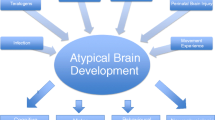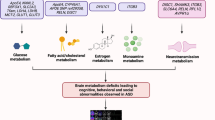Abstract
Much existing research on Williams syndrome (WS) has focused on the individuals’ unusual cognitive profile, with less emphasis placed on the developmental and neural underpinnings of the disorder. We review recent findings from brain imaging and begin to discuss links from these data to the behavioral phenotype. Overall brain size is significantly reduced in individuals with WS, as it is in many mental retardation syndromes. However, the specific profile of deficits in WS, particularly the visuospatial deficits, appears to be linked to parietal lobe abnormalities. Results from both genetic and brain imaging studies have provided useful insights into WS neurobiology. However, future work needs to remediate the lack of studies investigating developmental processes.
Similar content being viewed by others
References and Recommended Reading
Morris CA, Dempsey SA, Leonard CO, et al.: Natural history of Williams syndrome: physical characteristics. J Pediatr 1988, 113: 318–326.
Stromme P, Bjornstad PG, Ramstad K: Prevalence estimation of Williams syndrome. J Child Neurol 2002, 17: 269–271.
Mervis CB, Klein-Tasman BP: Williams syndrome: cognition, personality, and adaptive behaviour. Ment Retard Dev Disabil Res Rev 2000, 6: 148–158.
Dykens EM: Anxiety, fears, and phobias in persons with Williams syndrome. Dev Neuropsychol 2003, 23: 291–316.
Mervis CB, Robinson BF, Bertrand J, et al.: The Williams syndrome cognitive profile. Brain Cogn 2000, 44: 604–628.
Tassabehji M: Williams-Beuren syndrome: a challenge for genotype-phenotype correlations. Hum Mol Genet 2003, 12: R229–R237.
Morris CA, Mervis CB, Hobart HH, et al.: GTF2I hemizygosity implicated in mental retardation in Williams syndrome: genotype-phenotype analysis of five families with deletions in the Williams syndrome region. Am J Med Genet A 2003, 123: 45–59.
Meng Y, Zhang Y, Tregoubov V, et al.: Abnormal spine morphology and enhanced LTP in LIMK-1 knockout mice. Neuron 2002, 35: 121–133.
Frangiskakis JM, Ewart AK, Morris CA, et al.: LIMkinase1 hemizygosity implicated in impaired visuospatial constructive cognition. Cell 1996, 86: 59–69.
Tassabehji M, Metcalfe K, Karmiloff-Smith A, et al.: Williams syndrome: use of chromosomal microdeletions as a tool to dissect cognitive and physical phenotypes. Am J Hum Genet 1999, 64: 118–125.
Gray V, Karmiloff-Smith A, Funnell E, Tassabehji M: Indepth analysis of spatial cognition in Williams syndrome: a critical assessment of the role of the LIMK1 gene. Neuropsychologia 2006, 44: 679–685.
Tassabehji M, Hammond P, Karmiloff-Smith A, et al.: GTF2IRD1 in craniofacial development of humans and mice. Science 2005, 310: 1184–1187.
Hoogenraad CC, Koekkoek B, Akhmanova A, et al.: Targeted mutation of Cyln2 in the Williams syndrome critical region links CLIP-115 haploinsufficiency to neurodevelopmental abnormalities in mice. Nat Genet 2002, 32: 116–127.
Meyer-Lindenberg A, Mervis CB, Sarpal D, et al.: Functional, structural, and metabolic abnormalities of the hippocampal formation in Williams syndrome. J Clin Invest 2005, 115: 1888–1895.
Zhao C, Aviles A, Abel RA, et al.: Hippocampal and visuospatial learning defects in mice with a deletion of frizzled 9, a gene in the Williams syndrome deletion interval. Development 2005, 132: 2917–2927.
Karmiloff-Smith A: Development itself is the key to understanding developmental disorders. Trends Cogn Sci 1998, 2: 389–398.
Reiss AL, Eckert MA, Rose FE, et al.: An experiment of nature: Brain anatomy parallels cognition and behavior in Williams syndrome. J Neurosci 2004, 24: 5009–5015.
Meyer-Lindenberg A, Kohn P, Mervis CB, et al.: Neural basis of genetically determined visuospatial construction deficit in Williams syndrome. Neuron 2004, 43: 623–631.
Thompson PM, Lee AD, Dutton RA, et al.: Abnormal cortical complexity and thickness profiles mapped in Williams syndrome. J Neurosci 2005, 25: 4146–4158.
Willerman L, Schultz R, Rutledge JN, Bigler ED: In vivo brain size and intelligence. Intelligence 1991, 15: 223–228.
Jackowski AP, Papademetris X, Klaiman CK, et al.: A non-linear intensity-based brain morphometric analysis of Williams syndrome. Poster presented at the 10th Annual Meeting of the Organization for Human Brain Mapping. Budapest, Hungary; June 13–17, 2004.
Jones W, Hesselink J, Courchesne E, et al.: Cerebellar abnormalities in infants and toddlers with Williams syndrome. Dev Med Child Neurol 2002, 44: 688–694.
Thomas MS, Karmiloff-Smith A: Can developmental disorders reveal the component parts of the human language faculty? Lang Learn Dev 2005, 1: 65–92.
Schultz RT: Developmental deficits in social perception in autism: the role of the amygdala and fusiform face area. Int J Dev Neurosci 2005, 23: 125–141.
Galaburda AM, Holinger DP, Bellugi U, Sherman GF: Williams syndrome: neuronal size and neuronal-packing density in primary visual cortex. Arch Neurol 2002, 59: 1461–1467.
Boddaert N, Mochel F, Meresse I, et al.: Parieto-occipital grey matter abnormalities in children with Williams syndrome. Neuroimage 2006, 30: 721–725.
Eckert MA, Eliez S, Bellugi U, et al.: Evidence for superior parietal impairment in Williams syndrome. Neurology 2005, 64: 152–153.
Vicari S, Bellucci S, Carlesimo GA: Visual and spatial long-term memory: differential pattern of impairments in Williams and Down syndromes. Dev Med Child Neurol 2005, 47: 305–311.
Bellugi U, Wang PP, Jernigan T: Williams syndrome: an unusual neuropsychological profile. In Atypical Cognitive Developmental Disorders: Implications for Brain Function. Edited by Broman SH, Grafman J. Hillsdale, NJ: Lawrence Erlbaum Associates; 1994: 23–56.
Farran EK, Jarrold C: Visuospatial cognition in Williams syndrome: reviewing and accounting for the strengths and weaknesses in performance. Dev Neuropsychol 2003, 23: 173–200.
Farran EK, Jarrold C, Gathercole SE: Divided attention, selective attention and drawing: Processing preferences in Williams syndrome are dependent on the task administered. Neuropsychologia 2003, 41: 676–687.
Pani JR, Mervis CB, Robinson BF: Global spatial organization by individuals with Williams syndrome. Psychol Sci 1999, 10: 453–458.
Atkinson J, Braddick O, Anker S, et al.: Neurobiological models of visuospatial cognition in children with Williams syndrome: measures of dorsal-stream and frontal function. Dev Neuropsychol 2003, 23: 139–172.
Atkinson J, Braddick O, Rose FE, et al.: Dorsal-stream motion processing deficits persist into adulthood in Williams syndrome. Neuropsychologia 2005, 44: 828–833.
Landau B, Hoffman JE, Kurz N: Object recognition with severe spatial deficits in Williams syndrome: sparing and breakdown. Cognition 2006, 100: 483–510.
Schmitt JE, Watts K, Eliez S, et al.: Increased gyrification in Williams syndrome: evidence using 3D MRI methods. Dev Med Child Neurol 2002, 44: 292–295.
Gaser C, Luders E, Thompson PM: Increased local gyrification mapped in Williams syndrome. Neuroimage 2006, 33: 46–54.
Kippenhan JS, Olsen RK, Mervis CB, et al.: Genetic contributions to human gyrification: sulcal morphometry in Williams syndrome. J Neurosci 2005, 25: 7840–7846.
Van Essen DC, Dierker D, Snyder AZ: Symmetry of cortical folding abnormalities in Williams syndrome revealed by surface-based analyses. J Neurosci 2006, 26: 5470–5483.
Jackowski AP, Schultz RT: Foreshortened dorsal extension of the central sulcus in Williams syndrome. Cortex 2005, 41: 282–290.
Mima T, Mikawa T: Folding of the tectal cortex by local remodeling of neural differentiation. Dev Dyn 2004, 229: 475–479.
Ansari D, Dhital B, Siong CS: Parametric effects of numerical distance on the intraparietal sulcus during passive viewing of rapid numerosity changes. Brain Res 2006, 1067: 181–188.
Molko N, Cachia A, Riviére D, et al.: Functional and structural alterations of the intraparietal sulcus in a developmental dyscalculia of genetic origin. Neuron 2003, 40: 847–858.
Paterson S, Girelli L, Butterworth B, Karmiloff-Smith A: Are numerical difficulties syndrome specific? Evidence from Williams syndrome and Down’s syndrome. J Child Psychol Psychiatry 2006, 47: 190–204.
Deruelle C, Rondan C, Mancini J, Livet M: Exploring face processing in Williams syndrome. Cognitie Creier Comportanent 2003, 7: 157–171.
Tager-Flusberg H, Plesa-Skwerer D, Faja S, Joseph RM: People with Williams syndrome process faces holistically. Cognition 2003, 89: 11–24.
Rose FE, Lincoln A, Lai Z, et al.: Orientation and affective expression effects on facial recognition in Williams syndrome and Autism. J Autism Dev Disord 2006 [Epub ahead of print].
Karmiloff-Smith A, Thomas M, Annaz D, et al.: Exploring the Williams syndrome face processing debate: the importance of building developmental trajectories. J Child Psychol Psychiatry 2004, 45: 1258–1274.
Mobbs D, Garrett AS, Menon V, et al.: Anomalous brain activation during face and gaze processing in Williams syndrome. Neurology 2004, 62: 2070–2076.
Grice SJ, Spratling MW, Karmiloff-Smith A, et al.: Disordered visual processing and oscillatory brain activity in autism and Williams syndrome. Neuroreport 2001, 12: 2697–2700.
Carmichael ST, Price JL: Limbic connections of the orbital and medial prefrontal cortex in macaque monkeys. J Compar Neurol 1995, 363: 615–641.
Tager-Flusberg H, Sullivan K: A componential view of theory of mind: evidence from Williams syndrome. Cognition 2000, 76: 59–90.
Plesa Skwerer D, Verbalis A, Scholield C, et al.: Socialperceptual abilities in adolescents and adults with Williams syndrome. Cogn Neuropsychol 2006, 23: 338–349.
Meyer-Lindenberg A, Hariri AR, Munoz KE, et al.: Neural correlates of genetically abnormal social cognition in Williams syndrome. Nat Neurosci 2005, 8: 991–993.
Author information
Authors and Affiliations
Corresponding author
Rights and permissions
About this article
Cite this article
Paterson, S.J., Schultz, R.T. Neurodevelopmental and behavioral issues in Williams syndrome. Curr Psychiatry Rep 9, 165–171 (2007). https://doi.org/10.1007/s11920-007-0087-6
Published:
Issue Date:
DOI: https://doi.org/10.1007/s11920-007-0087-6




